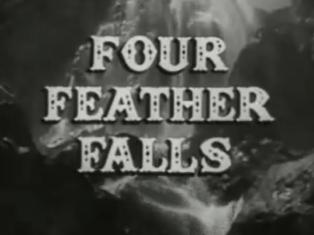
Four Feather Falls is a British television programme, the third puppet TV show produced by Gerry Anderson for Granada Television. It was based on an idea by Barry Gray, who also wrote the show's music. The series was the first to use an early version of Anderson's Supermarionation puppetry. Thirty-nine 13-minute episodes were produced, broadcast by Granada from February until November 1960.
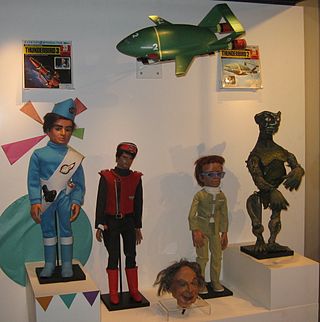
Supermarionation is a style of television and film production employed by British company AP Films in its puppet TV series and feature films of the 1960s. These productions were created by Gerry and Sylvia Anderson and filmed at APF's studios on the Slough Trading Estate. The characters were played by electronic marionettes with a moveable lower lip, which opened and closed in time with pre-recorded dialogue by means of a solenoid in the puppet's head or chest. The productions were mostly science fiction with the puppetry supervised by Christine Glanville, art direction by either Bob Bell or Keith Wilson, and music composed by Barry Gray. They also made extensive use of scale model special effects, directed by Derek Meddings.

Sylvia Beatrice Anderson was an English television and film producer, writer, voice actress and costume designer, best known for her collaborations with Gerry Anderson, her husband between 1960 and 1981. In addition to serving as co-creator and co-writer on their TV series during the 1960s and early 1970s, Anderson's primary contribution was character development and costume design. She regularly directed the fortnightly voice recording sessions, and provided the voices of many female and child characters. She also helped develop the shows and characters, in particular creating the iconic characters of Lady Penelope and Parker in Thunderbirds.
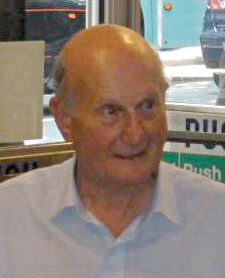
Gerald Alexander Anderson was an English television and film producer, director, writer and occasional voice artist, who is known for his futuristic television programmes, especially his 1960s productions filmed with "Supermarionation".

Stingray is a British children's science fiction television series created by Gerry and Sylvia Anderson and produced by AP Films (APF) for ITC Entertainment. Filmed in 1963 using a combination of electronic marionette puppetry and scale model special effects, it was APF's sixth puppet series and the third to be produced under the banner of "Supermarionation". It premiered in October 1964 and ran for 39 half-hour episodes.

Supercar is a British children's science fiction television series produced by Gerry Anderson and Arthur Provis' AP Films (APF) for Associated Television and ITC Entertainment. Two series totalling 39 episodes were filmed between September 1960 and January 1962. Budgeted at £2,000 per episode, it was Anderson's first half-hour series as well as his first science fiction production.
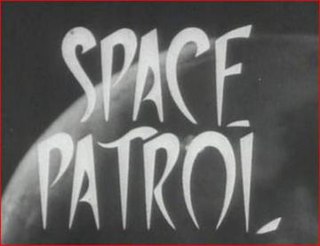
Space Patrol is a British science-fiction television series featuring marionettes that was produced in 1962 and broadcast from the beginning of April 1963. It was written and produced by Roberta Leigh in association with ABC Weekend TV.

Fireball XL5 is a 1960s British children's science-fiction puppet television series about the missions of Fireball XL5, a vessel of the World Space Patrol that polices the cosmos in the year 2062. Commanded by Colonel Steve Zodiac, XL5 defends Earth from interstellar threats while encountering a wide variety of alien civilisations.

AP Films or APF was a British independent film production company of the 1950s until the early 1970s. The company became internationally known for its imaginative children's action-adventure marionette television series – most significantly Thunderbirds – produced for British ITV network companies Associated-Rediffusion, Granada, ABC and ATV. At its height, the company employed more than 200 staff.

Thunderbirds Are Go is a 1966 British science-fiction puppet film based on Thunderbirds, a Supermarionation television series created by Gerry and Sylvia Anderson and produced by their company Century 21 Productions. Written by the Andersons and directed by David Lane, Thunderbirds Are Go concerns spacecraft Zero-X and its human mission to Mars. When Zero-X suffers a malfunction during re-entry, it is up to life-saving organisation International Rescue, supported by its technologically-advanced Thunderbird machines, to activate the trapped crew's escape pod before the spacecraft hits the ground.

Torchy the Battery Boy is a British television series, the second produced by AP Films and Gerry Anderson, running from 1959 to 1961. Directed by Anderson, it was a collaboration with author Roberta Leigh, with music scored by Barry Gray, art direction from Reg Hill and special effects by Derek Meddings.

The Century 21 Organisation was a group of companies founded by Gerry Anderson in the early 1960s to expand on his television production company, AP Films (APF; later Century 21 Productions). In addition to APF, the group included:
"The Perils of Penelope" is an episode of Thunderbirds, a British Supermarionation television series created by Gerry and Sylvia Anderson and filmed by their production company AP Films for ITC Entertainment. Directed by Alan Pattillo and Desmond Saunders from a script by Pattillo, it was first broadcast on 14 October 1965 on ATV Midlands as the third episode of Series One. It is the 12th episode in the official running order.
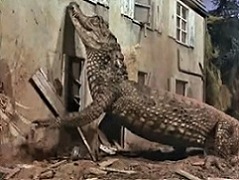
"Attack of the Alligators!" is an episode of Thunderbirds, a British Supermarionation television series created by Gerry and Sylvia Anderson and filmed by their production company AP Films (APF) for ITC Entertainment. Written by Alan Pattillo and directed by David Lane, it was first broadcast on 10 March 1966 on ATV Midlands as the 23rd episode of Series One. It is the 24th episode in the official running order.

Crossroads to Crime is a 1960 British crime film produced and directed by Gerry Anderson and distributed by Anglo-Amalgamated (AA). Starring Anthony Oliver, George Murcell, Miriam Karlin, David Graham and Ferdy Mayne, Crossroads to Crime is about a police constable who works undercover to bring down a gang of lorry hi-jackers. Made as a B movie by Anderson's production company AP Films (APF), which made children's puppet television series, it was APF's first film production as well as its first production with live actors. It was also the only film that Anderson directed.

Reginald Eric Hill was an English model-maker, art director, producer, and freelance storyboard artist. He is most prominently associated with the work of Gerry Anderson.
Roberta Leigh was an assumed name for Rita Lewin who was a British author, artist, composer and television producer. She wrote romance fiction and children's stories under the pseudonyms Roberta Leigh, Rachel Lindsay, Janey Scott and Rozella Lake.
Arthur John Provis was an English cinematographer and producer, best known for co-founding AP Films with Gerry Anderson.
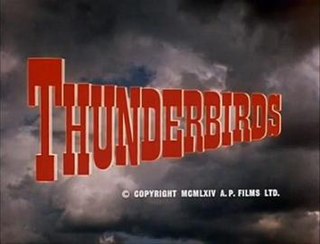
Thunderbirds is a British science fiction television series created by Gerry and Sylvia Anderson, filmed by their production company AP Films (APF) and distributed by ITC Entertainment. It was made between 1964 and 1966 using a form of electronic marionette puppetry combined with scale model special effects sequences. Two series, totalling thirty-two 50-minute episodes, were filmed; production ended with the completion of the sixth episode of the second series after Lew Grade, the Andersons' financial backer, failed in his bid to sell the programme to American network television.
"Tom Thumb Tempest" is the 22nd episode of Stingray, a British Supermarionation television series created by Gerry and Sylvia Anderson and produced by their company AP Films (APF) for ITC Entertainment. Written by Alan Fennell and directed by Alan Pattillo, it was first broadcast on 28 February 1965 on the Anglia, ATV London, Grampian and Southern franchises of the ITV network. It subsequently aired on ATV Midlands on 3 March 1965.
















